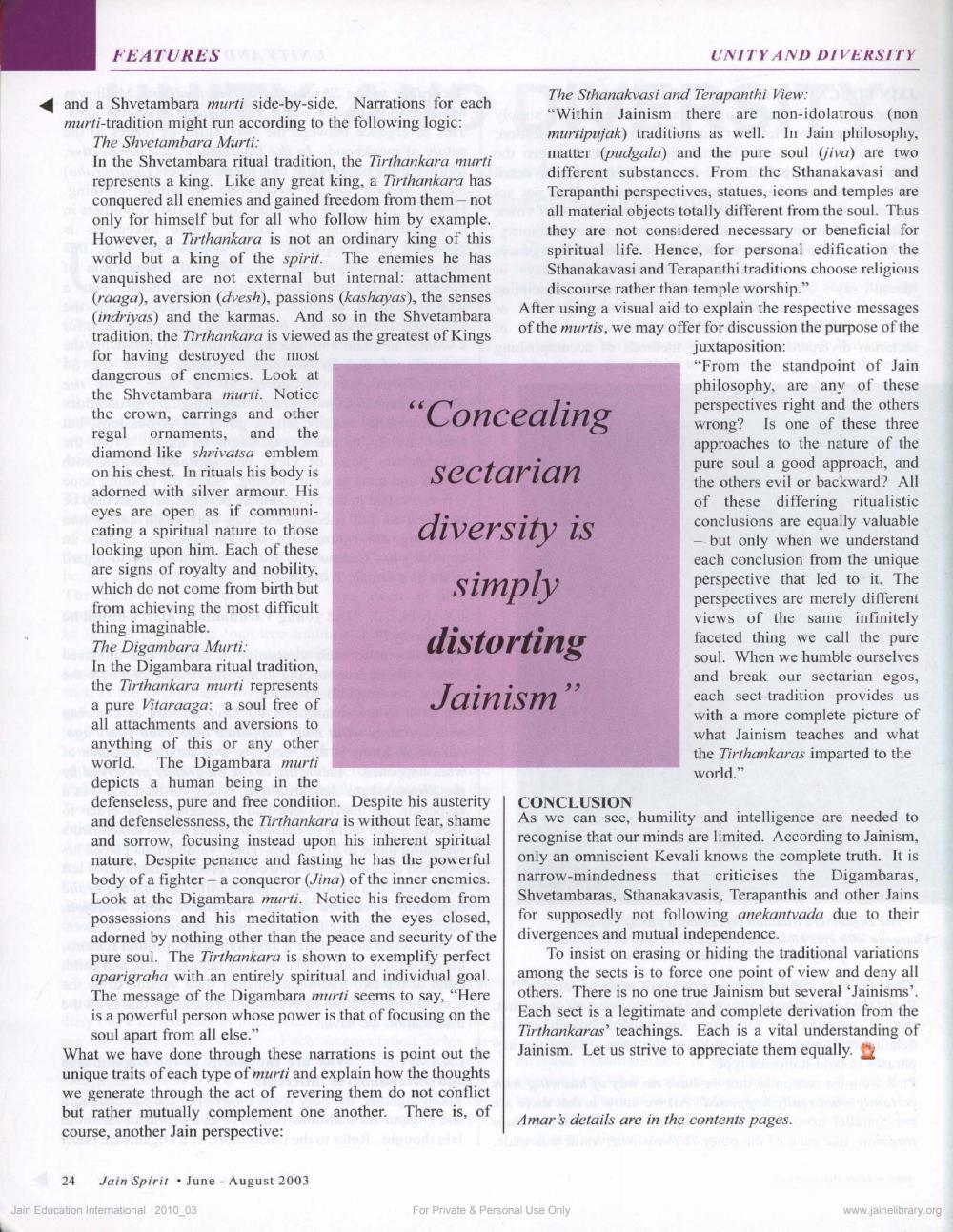________________
FEATURES
UNITY AND DIVERSITY
and a Shvetambara murti side-by-side. Narrations for each
The Sthanakvasi and Terapanthi View: murti-tradition might run according to the following logic:
"Within Jainism there are non-idolatrous (non The Shvetambara Murti:
murtipujak) traditions as well. In Jain philosophy, In the Shvetambara ritual tradition, the Tirthankara murti
matter (pudgala) and the pure soul (iva) are two represents a king. Like any great king, a Tirthankara has
different substances. From the Sthanakavasi and conquered all enemies and gained freedom from them - not
Terapanthi perspectives, statues, icons and temples are only for himself but for all who follow him by example.
all material objects totally different from the soul. Thus However, a Tirthankara is not an ordinary king of this
they are not considered necessary or beneficial for
spiritual life. Hence, for personal edification the world but a king of the spirit. The enemies he has vanquished are not external but internal: attachment
Sthanakavasi and Terapanthi traditions choose religious (raaga), aversion (dvesh), passions (kashayas), the senses
discourse rather than temple worship." (indriyas) and the karmas. And so in the Shvetambara
After using a visual aid to explain the respective messages tradition, the Tirthankara is viewed as the greatest of Kings
of the murtis, we may offer for discussion the purpose of the for having destroyed the most
juxtaposition: dangerous of enemies. Look at
"From the standpoint of Jain the Shvetambara murti. Notice
philosophy, are any of these the crown, earrings and other
perspectives right and the others regal ornaments, and the
wrong? Is one of these three diamond-like shrivatsa emblem
approaches to the nature of the on his chest. In rituals his body is
pure soul a good approach, and adorned with silver armour. His
the others evil or backward? All eyes are open as if communi
of these differing ritualistic
conclusions are equally valuable cating a spiritual nature to those looking upon him. Each of these
– but only when we understand are signs of royalty and nobility,
each conclusion from the unique which do not come from birth but
perspective that led to it. The from achieving the most difficult
perspectives are merely different thing imaginable.
views of the same infinitely The Digambara Murti:
faceted thing we call the pure In the Digambara ritual tradition,
soul. When we humble ourselves the Tirthankara murti represents
and break our sectarian egos, a pure Vitaraaga: a soul free of
each sect-tradition provides us all attachments and aversions to
with a more complete picture of anything of this or any other
what Jainism teaches and what world. The Digambara murti
the Tirthankaras imparted to the depicts a human being in the
world." defenseless, pure and free condition. Despite his austerity | CONCLUSION and defenselessness, the Tirthankara is without fear, shame As we can see, humility and intelligence are needed to and sorrow, focusing instead upon his inherent spiritual recognise that our minds are limited. According to Jainism, nature. Despite penance and fasting he has the powerful only an omniscient Kevali knows the complete truth. It is body of a fighter - a conqueror (Jina) of the inner enemies. narrow-mindedness that criticises the Digambaras, Look at the Digambara murti. Notice his freedom from
Shvetambaras, Sthanakavasis, Terapanthis and other Jains possessions and his meditation with the eyes closed, for supposedly not following anekantvada due to their adorned by nothing other than the peace and security of the divergences and mutual independence. pure soul. The Tirthankara is shown to exemplify perfect To insist on erasing or hiding the traditional variations aparigraha with an entirely spiritual and individual goal. among the sects is to force one point of view and deny all The message of the Digambara murti seems to say, "Here others. There is no one true Jainism but several 'Jainisms'. is a powerful person whose power is that of focusing on the
Each sect is a legitimate and complete derivation from the soul apart from all else."
Tirthankaras' teachings. Each is a vital understanding of What we have done through these narrations is point out the Jainism. Let us strive to appreciate them equally. unique traits of each type of murti and explain how the thoughts we generate through the act of revering them do not conflict but rather mutually complement one another. There is, of
Amar s details are in the contents pages. course, another Jain perspective:
“Concealing
sectarian diversity is
simply distorting Jainism”
24
Jain Spirit
June - August 2003
Jain Education International 2010_03
For Private & Personal Use Only
www.jainelibrary.org




